
세계의 선박용 엔진 시장은 2024년 89억 달러로 평가되었고, 2025-2034년 CAGR 3.8%로 꾸준한 성장이 예상됩니다.
세계 무역과 운송이 크게 변모하고 있는 가운데, 진화하는 비용, 공급망 모델, 물류의 틀이 국제 상거래의 풍경을 재구성하고 있습니다. 이러한 변화는 각국의 경쟁에 영향을 미치며, 각국은 세계적인 운송 네트워크에 더욱 통합되고 있습니다. 무역은 여전히 경제 개발에 필수적인 원동력이며, 보다 효율적인 해양 엔진에 대한 수요를 부추기고 있습니다. 항만 인프라에 대한 투자 증가, 선박 기술의 급속한 진보, 해상 수송량 증가는 모두 시장을 강화하는 요인입니다. 환경 문제에 대한 관심이 계속 증가하고 있는 가운데, 특히 연료 효율 및 배출가스 절감 등 환경 친화적인 솔루션으로의 전환이 현저해지고 있습니다. 세계적으로 더 엄격한 규제가 시행되고 있는 가운데, 지속 가능한 선박용 엔진 기술에 대한 주목이 시장의 중심적인 촉진요인이 되고 있습니다.

고속 선박용 엔진에 대한 수요는 2034년까지 20억 달러에 달할 것으로 예상됩니다. 이 급증은 항만 시설의 개발이 진행되고 있으며 강력한 태그 보트 수요가 증가하고 있기 때문입니다. 소형 선박, 요트, 페리 및 어선은 효율을 향상시킬 뿐만 아니라 연료 소비와 운영 비용을 절감하는 컴팩트한 엔진 설계를 채택하고 있습니다. 이러한 엔진은 전반적인 환경 실적 감소에 기여하면서 뛰어난 성능을 발휘하므로 다양한 해양 용도에서 매우 매력적인 옵션이 되었습니다.
| 시장 범위 | |
|---|---|
| 시작 연도 | 2024년 |
| 예측 연도 | 2025-2034년 |
| 시작 금액 | 89억 달러 |
| 예측 금액 | 129억 달러 |
| CAGR | 3.8% |
한편, MDO(선박용 디젤 오일) 선박용 엔진 분야는 2034년까지 연평균 복합 성장률(CAGR) 4%로 성장할 전망입니다. 이 엔진은 효율성과 소음 수준을 낮게 유지하면서 고속 운항을 유지하는 능력으로 인기가 상승하고 있습니다. 4스트로크 엔진의 설계는 1사이클마다 연료를 소비함으로써 연료 효율을 높이고 있으며, 스트로크마다 연료를 소비하는 2스트로크 엔진과는 다른 특징을 가지고 있습니다. 또한 MDO 엔진은 오일이나 윤활유의 주입이 필요 없기 때문에 배출가스가 적고 친환경적입니다.
미국의 선박용 엔진 시장도 크게 확대되고 있으며, 2034년까지 10억 달러를 창출할 것으로 예측되고 있습니다. 디젤 엔진 기술의 진보는 제조업체가 성능 향상을 위해 기술 혁신을 계속하고 있기 때문에 수요 촉진에 중요한 역할을 수행합니다. 경제 성장, 신뢰할 수 있는 엔진 성능에 대한 주목 증가, 고급스럽고 편안한 기능에 대한 투자 증가는 이 확대의 주요 요인입니다. 또한 해상 운송의 지속적인 성장은 보다 진보되고 효율적인 선박용 엔진에 대한 장기적인 요구를 야기하고 있습니다. 이러한 다면적 개발은 미국 시장의 지속적인 성장 궤도를 반영합니다.
The Global Marine Engines Market, valued at USD 8.9 billion in 2024, is poised for steady growth with an expected CAGR of 3.8% from 2025 to 2034. As global trade and transportation undergo significant transformation, evolving costs, supply chain models, and logistics frameworks are reshaping the landscape of international commerce. These changes are influencing the competitiveness of nations, integrating them further into global transport networks. Trade remains an essential driver of economic development, fueling the demand for more efficient marine engines. The growing investments in port infrastructure, rapid advancements in vessel technology, and the increasing volume of seaborne transportation are all factors bolstering the market. As environmental concerns continue to rise, there is a notable shift towards eco-friendly solutions, particularly in fuel efficiency and emissions reduction. With more stringent regulations being enforced globally, the focus on sustainable marine engine technology is becoming a central market driver.

The demand for high-speed marine engines is projected to reach USD 2 billion by 2034. This surge can be attributed to the ongoing development of port facilities and the increasing demand for powerful tugboats. Small vessels, yachts, ferries, and fishing boats are particularly adopting compact engine designs that not only improve efficiency but also cut down fuel consumption and operational costs. These engines offer excellent performance while helping to reduce the overall environmental footprint, making them a highly attractive option across various marine applications.
| Market Scope | |
|---|---|
| Start Year | 2024 |
| Forecast Year | 2025-2034 |
| Start Value | $8.9 Billion |
| Forecast Value | $12.9 Billion |
| CAGR | 3.8% |
On the other hand, the MDO (Marine Diesel Oil) marine engine segment is set to grow at a CAGR of 4% through 2034. These engines are increasingly popular due to their efficiency and ability to maintain high-speed operations while keeping noise levels low. Their four-stroke engine design enhances fuel efficiency by consuming fuel every other cycle, a feature that distinguishes them from two-stroke engines that consume fuel with every stroke. Additionally, MDO engines don't require oil or lubricant injections, making them more eco-friendly by producing fewer emissions, thus aligning with tightening environmental regulations.
The U.S. marine engines market is also witnessing considerable expansion, projected to generate USD 1 billion by 2034. Advancements in diesel engine technology are playing a significant role in driving demand as manufacturers continue to innovate for better performance. Economic growth, an increasing focus on reliable engine performance, and rising investment in luxury and comfort features are key contributors to this expansion. Furthermore, the continuous growth in seaborne transportation is creating a long-term need for more advanced and efficient marine engines. This multi-faceted development reflects the sustained growth trajectory of the market in the U.S.